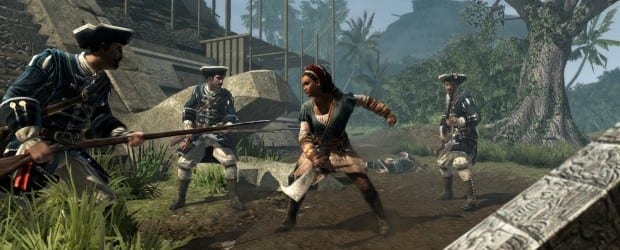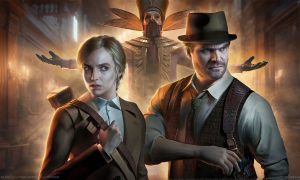
The Assassin’s Creed series has become one of the biggest sellers for Ubisoft. The first game spawned tie-in games for the Nintendo DS and PSP, and the second game spawned two direct sequels as well as a tie-in game on the DS. Now Assassin’s Creed III is out, but the Vita is getting its own Assassin’s Creed experience. Get ready for Liberation.
Liberation may be an Assassin’s Creed game, but it doesn’t have the usual male protagonist, or the same one as Assassin’s Creed III. Instead, you’ll be following the exploits of Aveline de Grandpre. A woman of French and African descent, she lives in New Orleans with her father and step-mother. You’ll not only learn about her journey to become an Assassin, but how she uses her skills to assist oppressed slaves.
Aveline uses three different Personas throughout the game, which give her different abilities and let her blend in using different methods. She is the daughter of a wealthy businessman, so she is well loved throughout the community she lives in. Because of his wealth, she has an air of class about her. This is the Lady Persona. She can walk easiest amongst the people, but she is also weaker because she doesn’t have as much armor. She also isn’t able to climb buildings and traverse rooftops. She can use her charms to convince someone to be her bodyguard, as well as bribe guards to get to places she normally wouldn’t be able to.
[singlepic id=7458 w=320 h=240 float=left]The Assassin Persona looks the most like Altair and Ezio. Aveline feels at home in this Persona, where she is able to deal the most damage in combat, but she is also exposed because it the least subtle. She can use any weapons when using this Persona, whether ranged or close combat. It also gives her the most freedom to travel over rooftops and through tree branches.
Finally the Slave Persona allows Aveline to get around the most inconspicuously. Since she isn’t showing the same status as her Lady Persona, she can blend in easily. Carrying a crate or joining a group of sweepers lifts the suspicion of guards. Not only does she hide in plain sight, but the weapons she uses with this Persona have more common uses than disemboweling foes. The machete, whip, and blowpipe are all useful for purposes other than killing. Knowing when to use each Persona is helpful to completing the game. These can only be changed at certain areas.
While you aren’t going to be able to complete the game without getting a little blood on your hands, you want to make sure that you can do it as quietly as possible. Each Persona has its own Notoriety level. The higher the level is, the more attention you will immediately grab. At the first level guards see you and calmly investigate what you are doing. The next level they investigate you more quickly because they are watching for your presence. At the third and final level they know you are wanted and will go after you immediately. Each Persona has their own way of reducing Notoriety. The Assassin’s Notoriety goes down by using bribes, the Lady’s Notoriety goes down when witnesses are killed, and the Slave’s Notoriety lesses when Wanted posters are torn down. The Notoriety goes down when any of these actions occur, no matter which Persona is currently being used.
Aveline has a high profile and a low profile which change how detectable she is and which actions she can perform. The low profile lets her walk around and blend in amongst the townspeople, but she can’t go any faster than a fast walk. The low profile also allows her to sit down or sweep to hide from suspicion. To do any running or vertical movement you need to access the high profile. By hitting the R button you can run, climb up walls, and run across rooftops without skipping a beat. Aveline will go from safe jump to safe jump as long as it’s possible. If you aren’t able to do it, you can still perform an unsafe jump if you wish, but the higher up you are the more damage you can take from performing it.
Graphically, the game looks good from a distance. Once you get up close however, the true nature of the polygon counts and blurry textures show up. Clipping can also be an issue, depending on where the camera is. The framerate stays smooth, unless multiple enemies attack you, which can cause it to drop below 30 fps. When the combat needs to be silky-smooth, the choppiness is disappointing.
[singlepic id=7460 w=320 h=240 float=right]The environments you travel through have a varied look to them. The city of New Orleans has a much different vibe from the bayou. Main characters in each area look much different, but the hired help all look similar.
The developers really wanted to get the feel of New Orleans right, and that includes all of the accents of the people dwelling there. If anything, I might have said that the accents were a bit too thick. At least there is an option for subtitles, which also translates certain phrases throughout. The amount of voice acting is impressive, but if you stay in one place for a while the same phrases can be heard over and over again.
The movement of Aveline across the rooftops and tree limbs feels spectacular. There is a bit of a rush watching her run off a rooftop, grab on a ledge by her fingertips, pull herself up, and then climb a new wall. It’s especially fluid once she has some momentum going. Unfortunately the combat feels very clunky, making it difficult to defeat many enemies surrounding you at the same time. The response time between hitting a button and performing the attack can be the difference between dying and surviving, making running a more viable option. Having the Chain-Kill ability helps alleviate this issue.
Ubisoft did try to make use of the features of the Vita. To target someone you can just tap on them on the screen. To pickpocket someone, you can run your finger down the back touchscreen. The same action can be used for rowing, but the X button works as well. To access your inventory, you touch the active inventory in the lower right corner and touch the option you want shown on the screen.
While Liberation is considered an open world game because you can move anywhere on the map you want to, the directives for each area are clear. The map system helps you see where you need to move to, and then you can try to resolve it however you like. The areas you explore feel spacious for a console game, but when you are outrunning the law that space can become cramped in a hurry.
If you can’t figure out where to go, you can make use of the Eagle Vision. While using this ability objects of interest will be highlighted in different colors depending on if they are allies, enemies, or important objects. You almost have to be right on top of the objective for it to be useful.
[singlepic id=7459 w=320 h=240 float=left]While the main objective of many missions is to kill a specific person, multiple options are available for you to complete that task. Sometimes there may be an extra bonus if you can kill the target with a specific weapon. It gives you an extra bonus in the game without making you feel too bad that you didn’t complete it that specific way. I do wish there would have been a way for multiple saves though, so I could try new approaches without starting over from the beginning of the game.
The multiplayer is a simulation of global war between the Assassins and the Templar. You have several agents that can be deployed across the globe. Your home node can be set up by using the location data in your Vita. Due to the asynchronous nature of the multiplayer, we’ll need to wait and see how well-supported it is.
If you have both the PS3 and Vita versions of Assassin’s Creed III and AC3: Liberation, you can access a special scenario for both games. This gives extra incentive to pick up the PS3 version if you get the Vita version, especially since both games are unique in their settings and character.
Liberation does provide a full Assassin’s Creed experience, and if you have played any of the previous games you’ll feel right at home. While the team has definitely put in a good effort to use all the features of the Vita, a few technical issues weigh it down. Still, it is a unique experience well worth owning, especially for any fan of Assassin’s Creed that owns a Vita.
While not working as a Database Administrator, Keith Schleicher has been associated with Gaming Trend since 2003. While his love of video games started with the Telestar Alpha (a pong console with four different games), he trule started playing video games when he received the ill-fated TI-99/4A. While the Speech Synthesizer seemed to be the height of gaming, eventually a 286 AT computer running at 8/12 Hz and a CGA monitor would be his outlet for a while. Eventually he’d graduate to 386, 486, Pentium, and Athlon systems, building some of those systems while doing some hardware reviews and attending Comdex. With the release of the Dreamcast that started his conversion to the console world. Since then he has acquired an NES, SNES, PS2, PS3, PSP, GBA-SP, DS, Xbox, Xbox 360, Xbox One S, Gamecube, Wii, Switch, and Oculus Quest 2. While not playing video games he enjoys bowling, reading, playing board games, listening to music, and watching movies and TV. He originally hails from Wisconsin but is now living in Michigan with his wife and sons.


 Buy Now
Buy Now
 Buy Now
Buy Now
 Buy Now
Buy Now
 Buy Now
Buy Now
 Buy Now
Buy Now
 Buy Now
Buy Now















